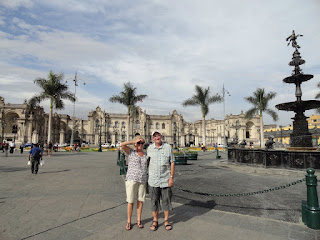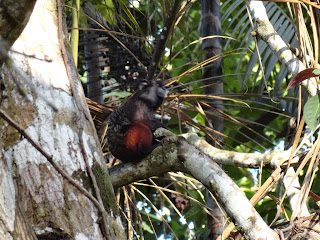Part one!
Our days at Ceiba Tops, Amazon Explorama Lodges (www.explorama.com) are pretty regimented, breakfast at 7:30, a two to three hour excursion at 8:30, lunch at 12:30, another excursion at 2:30 and dinner at 7:30 again. The rest of the day is free time, pool, hammock, etc.
Our first excursion was a jungle walk where we looked at the flora and fauna of the Amazon jungle, well mostly flora, as we did not see any type of animal. Lots of trees, vines, flowers and of course insects, millipedes, spiders, ants, more ants and one poisonous tree frog.
In the afternoon it was time to go piranha fishing, out across the Amazon in a flat bottomed boat. The river at this point is about three and half miles wide and flowing about nine kilometers per hour. Due to the high water many lakes and side streams are flooded contributing huge amounts of debris, logs and water plants, etc into the main stem.
 |
| Going into the Piranha swamp |
We just kind if slide around the debris, and pretty soon are forcing our way through the trees into flooded areas to fish for piranhas, ugly little critters, but good to eat. Not much success, twenty two tourists, and the boat drivers were the only ones to catch any fish, which the cooks fried up for dinner, the four little fish amounted to about one flake per tourist! Poor fishing is due to the flooding - we will try again later in the week.
 |
Piranha
|
The second morning we went about twenty minutes by boat were we all loaded into motokars for a short ride to a town of about 3000 called Mazan. This is a trading town on the Napo river and the road we took is the closest point between the Napo and the Amazon. The area around Mazan has all been cleared for agriculture growth.
 |
| Our motokar! |
The ride was very fun, it was like the Amazing Race, 11motokars, sometimes passing each other on a narrow little cement road, just wide enough for two motokars.
 |
| The race is on |
Then into the town which looks quite prosperous and busy. We went through the food market - raw fish, chickens and bush meat, lots of fruit and veggies and even the chewed mash that is used for the local brew (we did not buy any). The women pound this root, then chew the pulp and spit it all back into the mash where it ferments. When you want to drink it you buy a bag of the mash, mix it with river water and wowsiers!
 |
| The fish and chicken market |
We watched chickens being carted up the path to markets, bananas and veggies coming to town in a motokar. They were loading a big wooden ferry boat to go to Iquitos - the bottom deck with cows, buffalo, pigs etc, middle deck hammocks for sleeping and top deck for luggage. It will take about 24 hours to get to Iquitos. I wanted to watch them loading the livestock, but we could not wait. Although we did pass one with chickens tethered on the top deck, two roosts looking over the edge at the gringos going by, a pair of pigs in a pen at front, shades of the 1800's on the Mississippi!
 |
| People, Livestock and Freight Boat |
River families survive on fish from the river and the veggies and fruits they grow in their gardens and the plantations. Breakfast is usually fish and bananas and then lunch is bananas and fish, they usually only eat two meals per day. They also raise chickens, some beef, water buffalo, bananas, etc, but these are not for the family but for the market place, to be able to buy clothes, gasoline and other products that they now require. The water will continue to rise and flood until May and by that time some of the villagers will have to build rafts or platforms above the water to keep their chickens on.
Then we were back into the motokars for a twenty minute ride to the village, Indiana, located back on the Amazon. This was once a leper colony but some Canadian missionaries came with medicine and built a church and convent. They have since moved the lepers away, and now it is a little commercial town. It got its name from a local indigenous boy that went to medical school in Lima, then Peru, Indiana. He moved home and renamed the village Indiana.
There are fresh water dolphins in the Amazon, a much feared water animal by the river people. River people is the name the indigenous peoples in the Amazon area of Peru call themselves. Their total way of existence is tied to the rivers. These dolphins are bigger than the salt water dolphins, have more flexible bodies and are pink in color, especially the males. There are many legends or myths of people being taken for marriage by the dolphins, amongst other dolphin tricks! Although we seen a few, they do not perform acrobats like other dolphins, but only surface to breath and then dive again. Pictures are almost impossible, for me impossible, to take.
There is a large US Drug Enforcement Agency presence on the Amazon as a lot of product (cocaine) is transported on the river out through Columbia and Brazil, one dock has several large tug and freight boats sitting there, all confiscated by the DEA.
 |
| River barges confiscated by the joint Peru/USA drug agencies |
The afternoon was spent at an animal rescue center, where some animals are treated, rehabilitated and supposedly set free again. Maybe, it is more of a tourist attraction as most of the animals seemed free to leave but quite liked mooching and socializing with us gringo tourists.
There were several monkeys, a couple of which had a great desire to take your water bottle, open it, have a drink and then try and get you to have a drink also. One was busy trying to put the lid back on and knew it had to turn the opposite direction, but couldn't quite get it to thread.
 |
Macaw
|
My highlight was a pair of juvenile three toed sloths, the little female was heading some place on the ground, at three feet per minute, while the male just hung in the tree napping.
 |
| Just hanging out! |
Loreen was thrilled (not) with the sixteen foot Anaconda laying on the ground, as well as the baby anaconda and the baby constrictor that was cranky and would bite people.
 |
| Take note, neither Loreen or I are in the picture! |
And the most prehistoric turtle ever, a swamp turtle, it looks right out of Jurassic Park.
 |
| The turtle |
Amazon Explorama Lodges have five lodges scattered on the Amazon and Napo rivers, which are of various levels of convenience from open rooms with mosquito nets to fully enclosed with air conditioning. We were put in the most luxurious Ceiba Tops Lodge. At the very rustic Explorama Napo Lodge, an hour and half by speed boat from home base, we had the opportunity to walk above the canopy.
 |
| On the Canopy Walkway |
The highest point of the canopy walkway is 112 feet above ground, about 2,000 feet long consisting of fourteen separate spans. They are slung from the trees by cable, with nylon ropes attached to form a web which you walk within. The bottom is made of aluminum ladders end to end with a wooden walk way attached. It is quite a rush, especially when the next person steps on when you are in the middle of a span and it feels like it jumps three feet in the air. I did not see any wildlife, birds or even many insects - I was too busy looking for frayed rope and broken ladders. This was Loreen's idea if course.
 |
| Highest point |
All the lodges have mascots, macaws or parrots, that squawk for their crackers, but my favorite was Raul, a long legged water bird, that thinks he is human. On the thirty minute walk to the canopy tour, Raul tagged along, sometimes at the front or in the middle or at the end, like he was checking up on us. When we came down, at a separate tower there he was waiting for us to go home. Then when we went to visit the shamans, Raul was having a nap until he heard us crossing the bridge, then up he gets and hastily proceeds to the front of the group to make sure we don't get lost!
 |
| Raul |































































